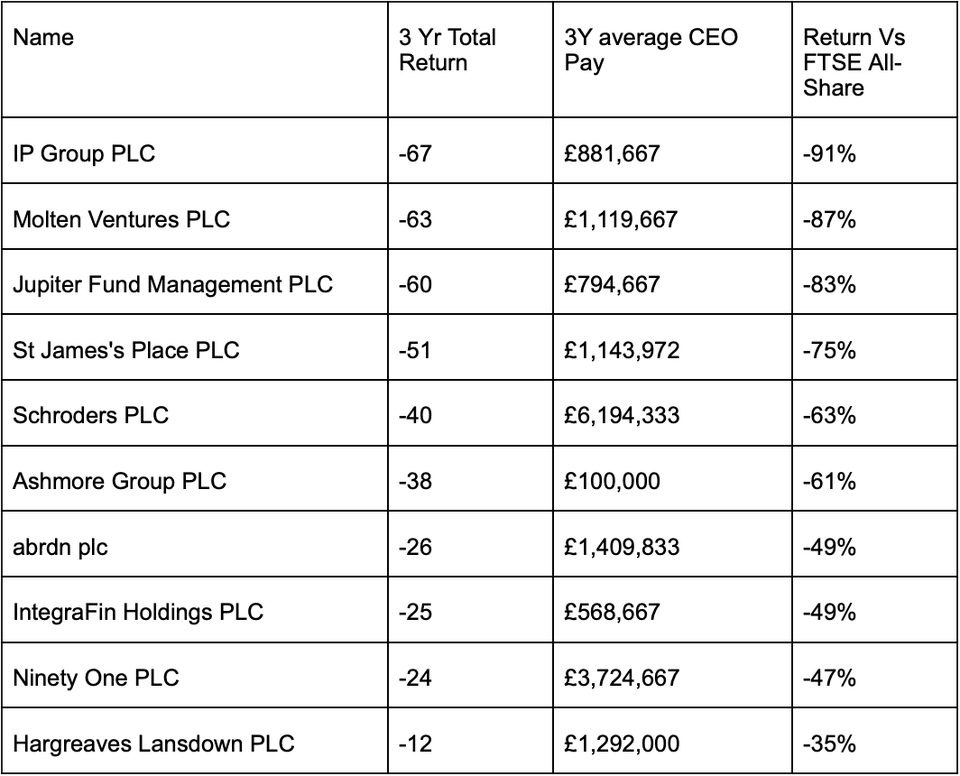There is no link between CEO pay and share price performance

Executive pay is one of the most debated topics in corporate governance, especially when set against the backdrop of stock market performance. In theory, CEOs’ remuneration packages should reflect their companies’ success, measured by long-term value creation and share price performance.
However, after we analysed the average remuneration (including bonuses) of FTSE 100 and FTSE 250 CEOs over the last three years against their companies’ performance over the last 3 years, the correlation between pay and share price performance is, at best, weak. This disconnect highlights concerns about the alignment of CEO incentives with shareholder interests.
|
Name |
3Y average CEO pay |
Return Vs FTSE All-Share |
|---|---|---|
|
Clarkson PLC |
£8,394,667 |
-20% |
|
Schroders PLC |
£6,194,333 |
-63% |
|
Carnival PLC |
£5,877,876 |
-45% |
|
Reckitt Benckiser Group PLC |
£4,957,224 |
-34% |
|
HSBC Holdings PLC |
£4,949,000 |
90% |
|
Tesco PLC |
£4,482,333 |
41% |
|
GSK PLC |
£4,328,333 |
6% |
|
Rolls-Royce Holdings PLC |
£4,263,000 |
328% |
|
AstraZeneca PLC |
£4,131,893 |
35% |
|
Glencore PLC |
£4,057,686 |
10% |
CEO Remuneration: Structure and Trends
CEO compensation in UK-listed companies typically comprises a base salary, annual bonuses, long-term incentive plans (LTIPs), and share options. For FTSE 100 CEOs, median total remuneration stood at £3.91 million in 2023, according to a report from the High Pay Centre, a slight increase from 2022 levels. FTSE 250 CEOs, received median packages of around £1.62 million in 2022. SCM’s research showed the average FTSE 100 CEO earned £2.44m in salary and bonus alone (even before share options etc) over the last 3 years and the average FTSE 250 CEO £1.33m.
Some of these salaries are eyewatering particularly as many of the highest paid CEOs saw their share prices fall over the last 3 years and their companies underperform their peers. For example, the CEO of Schroders received an average pay of £6.2m and yet the share price has fallen by 40% and has underperformed the stock market by 63% over the last three years.
One notable area was financial services companies, the average return of the stocks analysed versus the UK stock market was -10% over the last 3 years but the average salary was £1.6m pa. Some companies appear to have very bad performance against very high salaries – many of these firms are fund management groups:
Though remuneration often hinges on performance metrics like total shareholder return (TSR), earnings per share (EPS), and revenue growth, there is little evidence to suggest that higher pay equates to stronger share price performance. In fact, some of the highest-paid CEOs have overseen underperforming companies, while more modestly compensated executives have led companies that outperformed their sector peers.
Data Exposes Weak Correlation Between Pay and Performance
I conducted a detailed analysis comparing CEO remuneration (including base salary and bonuses) with their companies’ share price performance over three years. The results were striking across the FTSE 350. There is little evidence to support the notion that higher CEO pay leads to better share price performance.

There is a small correlation overall but it’s tiny!
Influence of Remuneration Committees
I believe one of the main reasons for this misalignment between pay and performance is the composition of remuneration committees.
These committees, responsible for setting CEO pay, are often chaired by individuals who are or have been CEOs themselves. Research from PIRC (Pensions & Investment Research Consultants) shows that in 2022, 35% of FTSE 100 remuneration committees were led by current or former CEOs. These individuals, tend to have experienced high pay packages during their own tenures, are therefore conflicted and promote over generous pay packages for their peers at other firms.
This creates an inherent conflict of interest, as remuneration committee members may be more inclined to approve high pay for
their counterparts, contributing to a self-reinforcing cycle of rising executive compensation.
An additional issue is that while “say-on-pay” votes have been introduced to give shareholders a greater voice in remuneration decisions, these votes remain largely advisory in the UK. Even when shareholders push back, companies frequently proceed with only minor adjustments to pay packages.
A notable example occurred in 2023, when despite receiving 30% opposition from shareholders, several FTSE 100 companies still approved CEO remuneration packages exceeding £5 million.
Sector-Specific Findings
The lack of correlation between CEO pay and performance is particularly evident in sectors with long product development cycles and significant regulatory oversight, such as pharmaceuticals and consumer goods.
In these industries, external factors—such as regulatory approvals or macroeconomic shifts—play a more substantial role in share price movements than the direct influence of management decisions. As a result, CEOs in these sectors can receive substantial bonuses based on meeting short-term financial metrics, even while their companies underperform relative to sector peers.
Incentive Misalignment
One key issue contributing to the pay-performance disconnect is the structure of executive pay packages. Short-term incentives,
such as annual bonuses, are often tied to short-term financial targets like revenue growth or EBITDA, which may not reflect sustainable, long-term value creation. Long-term incentive plans (LTIPs), while designed to reward long-term performance, often vest over relatively short periods—typically three years—and are frequently linked to TSR or EPS targets, which can be manipulated through share buybacks or aggressive cost-cutting.
This focus on short-term financial metrics incentivises CEOs to make decisions that boost immediate profitability at the expense of long-term growth. It also encourages risk-taking behaviour, where executives benefit disproportionately from stock price increases but face little personal financial downside if their strategies fail to deliver sustainable returns.
Reforming Executive Compensation
To align CEO incentives more closely with shareholder interests, companies should consider redesigning remuneration packages with a greater emphasis on long-term value creation.
I would suggest:
- extending the vesting periods for LTIPs to five to seven years would incentivise executives to focus on longer-term growth rather than short-term stock price movements.
- incorporating non-financial metrics—such as environmental, social, and governance (ESG) factors—into pay structures would encourage more sustainable corporate behaviour.
- remuneration committees should be more independent by limiting the number of current or former CEOs on these committees.
- enhanced shareholder engagement is also critical. Making “say-on-pay” votes binding, rather than advisory, would ensure that companies are held accountable for pay decisions that fail to reflect performance.
Conclusion
The assumption that high CEO pay guarantees strong company performance is not supported by the evidence.
My analysis of FTSE 100 and FTSE 250 companies shows that there is little correlation between executive pay and share price performance.
The structure of remuneration packages, coupled with the influence of remuneration committees, has created a system where CEO pay often outpaces shareholder returns.
For the long-term health of the UK corporate sector, reforming executive compensation to better align with sustainable growth is essential.
Sources:
1. High Pay Centre 2023 Report on CEO Pay: High Pay Centre Report https://highpaycentre.org
2. PIRC Report on Remuneration Committees: https://pirc.co.uk
3. The Guardian: Barclays CEO Pay and Shareholder Returns: https://www.theguardian.com/business/2023/jan/03/barclays-ceo-pay